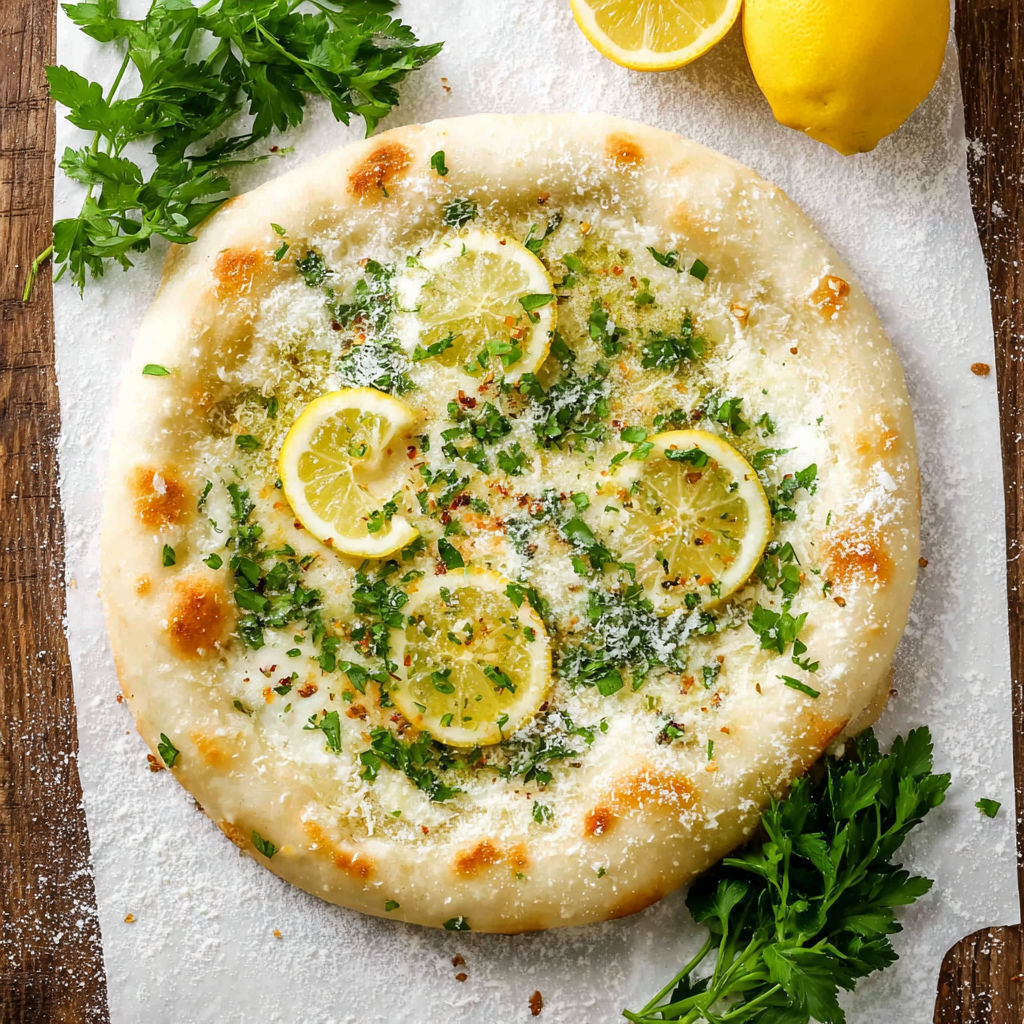 Pin
Pin
This bright lemon pizza brings sunshine to your dinner table with its perfect balance of creamy cheese and zesty citrus. The combination of fresh mozzarella, garlic, and lemon creates a light yet satisfying meal that stands out from traditional pizza options.
I first made this lemon pizza during a summer dinner party when I wanted something light yet impressive. The combination of reactions from skeptical first glances to delighted second slices has made this a staple in my entertaining rotation.
- Fresh mozzarella provides that classic pizza stretch and mild creaminess that carries the lemon flavor perfectly
- Extra virgin olive oil forms the base of your flavor brine look for a peppery variety for best results
- Fresh parsley adds a gentle herbaceous note that balances the acidity of the lemon
- Garlic infuses the oil with aromatic depth choose fresh cloves for the brightest flavor
- Lemon zest and juice deliver the signature brightness use organic lemons if possible for best flavor
- Pizza dough whether homemade or store bought provides the perfect canvas
- Prepare the dough
- Start with your pizza dough shaped into a 9×13 inch oval or rectangle on parchment paper. Create several small dimples across the surface with your fingertips to catch the flavorful brine.
- Create the lemon brine
- Combine olive oil water parsley grated garlic lemon zest lemon juice salt and pepper in a small jar. Shake vigorously until completely emulsified. The mixture should look creamy and unified not separated.
- Apply the brine and cheese
- Pour the lemon brine evenly over the dimpled dough making sure it pools in the little indentations. Distribute pieces of fresh mozzarella across the surface leaving some spaces between for the brine to bubble up during baking.
- Bake to perfection
- Transfer the pizza carefully to your preheated pizza stone or inverted baking sheet. Bake until the crust develops a golden brown color and the cheese becomes bubbly with light brown spots typically 8 to 10 minutes in a convection oven.
- Finish with fresh elements
- Remove from oven and immediately drizzle with fresh lemon juice. Sprinkle with grated parmesan and additional fresh parsley. Finish with freshly ground black pepper for a final layer of flavor.
The lemon brine is truly the secret weapon in this recipe. I discovered that allowing it to sit for even just five minutes before applying to the dough intensifies the flavors remarkably. My Italian grandmother would probably question this untraditional approach but even she became a convert after one bite.
The Perfect Crust
The key to this pizza is achieving a crust with the right balance of chew and crispness. The dimpling technique not only helps hold the lemon brine but also ensures the dough cooks evenly. If using homemade dough allow it to come to room temperature before shaping for the easiest stretching. For store bought dough let it rest outside the refrigerator for at least 30 minutes before working with it to relax the gluten.
Cheese Considerations
While fresh mozzarella is ideal for this recipe its high moisture content can sometimes make the pizza soggy. To prevent this pat the cheese dry with paper towels before placing on the pizza. If you prefer a more melty consistent coverage opt for low moisture mozzarella instead. The texture will be different but equally delicious. For an extra flavor dimension consider adding small dollops of ricotta cheese alongside the mozzarella.

Serving Suggestions
This lemon pizza works beautifully as a starter cut into small squares for a party or as a main dish paired with a simple arugula salad dressed with lemon vinaigrette to echo the flavors. For a complete meal serve alongside a bowl of light tomato soup or Mediterranean style grilled vegetables. The brightness of the pizza makes it particularly suitable for warm weather dining but its comforting cheese base ensures it works year round.

Recipe FAQs
- → Can I use bottled lemon juice instead of fresh?
Fresh lemon juice is strongly recommended for this pizza as it provides a brighter, more authentic flavor. Bottled lemon juice often contains preservatives that can affect the taste. The recipe only requires a small amount of fresh lemon juice and zest, which contributes significantly to the pizza's distinctive character.
- → What type of mozzarella works best for this pizza?
Both fresh mozzarella and firm mozzarella work well. Fresh mozzarella (packed in water) provides a creamier texture and milder flavor that pairs beautifully with the lemon. If using fresh, be sure to drain excess moisture by dabbing with paper towels. Firm, shredded mozzarella will give a more traditional pizza texture and more pronounced cheese flavor.
- → Can I prepare the lemon brine ahead of time?
Yes! The lemon-garlic brine can be prepared up to 24 hours in advance and stored in an airtight container in the refrigerator. This actually allows the flavors to meld together more thoroughly. Just be sure to shake it well again before using, as the oil and water components will separate during storage.
- → Is a pizza stone necessary for this recipe?
While a pizza stone creates the best crispy crust, it's not essential. You can use an inverted rimmed baking sheet preheated in the oven as an alternative. Place it on the lowest shelf of your oven during preheating, and it will help create a crisp crust similar to what you'd achieve with a stone.
- → What other toppings would pair well with lemon pizza?
This lemon pizza is wonderfully versatile. Consider adding thinly sliced prosciutto after baking for a salty contrast, or fresh arugula for a peppery bite. Thin slices of asparagus or artichoke hearts also complement the lemon flavor. For seafood lovers, adding cooked shrimp or small pieces of smoked salmon after baking creates a delicious variation.
- → How can I ensure my crust is crispy and not soggy?
To achieve a crispy crust, make sure your oven and pizza stone (or baking sheet) are fully preheated. If using fresh mozzarella, be sure to remove excess moisture by patting it dry. Apply the brine lightly and evenly, avoiding over-saturation in any one area. Finally, bake the pizza on the lowest rack of your oven where the heat is most intense.
